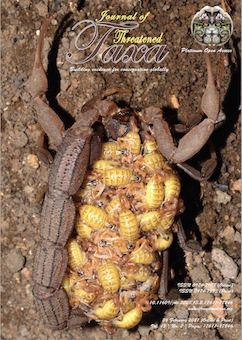Potential remote drug delivery failures due to temperature-dependent viscosity and drug-loss of aqueous and emulsion-based fluids
DOI:
https://doi.org/10.11609/jott.5745.13.2.17639-17645Keywords:
Darts, Emulsion, RDDS, Remote drug delivery, Tranquilizer, Vaccines, WildlifeAbstract
The ability to inject wild animals from a distance using remote drug delivery systems (RDDS) is one of the most effective and humane practices in wildlife management. Several factors affect the successful administration of drugs using RDDS. For example, temperature-dependent viscosity change in aqueous (Newtonian) or water-in-oil emulsion (non-Newtonian) fluids, commonly used in tranquilizer and adjuvant-based vaccines, respectively, can potentially result in drug delivery failure. To better understand impacts due to viscosity changes, we investigated the fluid dynamics and ballistics involved in remote drug delivery. Our research was divided into two phases: we investigated the viscosimetric physics in the first phase to determine the fluid behavior under different temperature settings, simulating recommended storage temperature (7ºC), plus an ambient temperature (20ºC). In the second phase of our study, we assessed the drug delivery efficiency by specialized darts, using a precision CO2 projector and a blowgun. Efficiency assessment was done by comparing the original drug volume with the actual volume injected after firing the dart into a fresh pork hide mounted on a ballistic gel. Before testing, we configured the required minimum impact velocity for our parameters and intramuscular injection (determined as ˃ 40 m/sec). All executed dart-deployments performed satisfactorily, despite initial concerns of potential incomplete drug delivery, however, noteworthy drug loss was observed (˃10%) associated with drug residues in syringe/dart dead space and within the transfer needle. This could potentially result in inaccurate dosing depending on the drug used. Furthermore, the use of a blowgun for remote drug delivery (>3m) is discouraged, especially when using specialized darts, as the required minimum dart velocity for adequate penetration is difficult to reach, in addition to a loss of precision during targeting.
References
Baker, D.L., M.A. Wild, M.D. Hussain, R.L. Dunn & T.M. Nett (2005).Evaluation of remotely delivered leuprolide acetate as a contraceptive agent in female elk (Cervus elaphus nelsoni). Journal of Wildlife Diseases 41(4): 758–767. https://doi.org/10.7589/0090-3558-41.4.758
Bobashev, G.V., & W.A. Zule (2010). Modeling the effect of high dead-space syringes on the human immunodeficiency virus (HIV) epidemic among injecting drug users. Addiction 105(8): 1439–1447. https://doi.org/10.1111/j.1360-0443.2010.02976.x
Cattet, M.R., A. Bourque, B.T. Elkin, K.D. Powley, D.B. Dahlstrom & N.A. Caulkett (2006). Evaluation of the potential for injury with remote drug-delivery systems. Wildlife Society Bulletin 34(3): 741–749. https://doi.org/10.2193/0091-7648(2006)34[741:EOTPFI]2.0.CO;2
Cracknell, J. (2013). Remote chemical injection: Darting in practice. In Practice 35(1): 17–23. https://doi.org/10.1136/inp.f12
Evans, C.S., A.J. DeNicola, J.D. Eisemann, D.C. Eckery & R.J. Warren (2015). Administering GonaConTM to white-tailed deer via hand-injection versus syringe-dart. Human Wildlife Interactions 9(2): 265–272. https://digitalcommons.usu.edu/hwi/vol9/iss2/15
Griffin, D. (2015). Darts to deliver medications is a serious BQA concern. http://gpvec.unl.edu/InTheNews/DartUseThoughts.pdf
Kirkpatrick, J.F., R.O. Lyda & K.M. Frank (2011). Contraceptive Vaccines for Wildlife: A Review. American Journal of Reproductive Immunology 66(1): 40–50. https://doi.org/10.1111/j.1600-0897.2011.01003.x
Kreeger, T.J. (1997). Overview of delivery systems for the administration of contraceptives to wildlife. In: Contraception in Wildlife Management. Technical Bulletin No. 1853. USDA. Washington, DC: US Government Printing Office, USA, 29–48pp.
Küme, T., A.R. Şişman, A. Solak, B. Tuğlu, B. Çinkooğlu & C. Çoker (2012). The effects of different syringe volume, needle size and sample volume on blood gas analysis in syringes washed with heparin. Biochemia Medica 22(2): 189–201. https://www.ncbi.nlm.nih.gov/pmc/articles/PMC4062339/
McCaan, B., D. Baker, J. Powers, A. Denicola, B. Soars & M. Thompson (2017). Delivery of GonaCon-Equine to Feral Horses (Equus caballus) Using Prototype Syringe Darts. Accessed on December 2019. https://www.wildlifefertilitycontrol.org/wp-content/uploads/2017/10/Delivery-of-GonaCon-Equine-to-feral-horses-Equus-caballus-using-protoype-syringe-darts-Blake-McCann.pdf
Palm, T., E. Sahin, R. Gandhi & M. Khossravi (2015). Temperature, Viscosity, and Concentration in Parenteral Drug Development. BioProcess International. Accessed in December 2019. https://bioprocessintl.com/manufacturing/monoclonal-antibodies/importance-concentration-temperature-viscosity-relationship-development-biologics/
R Core Team (2020). R: A language and environment for statistical computing. R Foundation for Statistical Computing, Vienna, Austria. Accessed in December 2019. http://www.r-project.org/index.html
Rosenfield, D. A. (2017). Introduction to Technical Aspects of Remote Drug Delivery Systems (*RDDS) with Telemetric Support in Free-Ranging Wildlife *RDDS = Remote Drug Delivery System. ABRAVAS Technical Bulletin, II. Accessed in December 2019. https://www.researchgate.net/publication/319910354_Introduction_to_Technical_Aspects_of_Remote_Drug_Delivery_Systems_RDDS_with_Telemetric_Support_in_Free-Ranging_Wildlife_RDDS_Remote_Drug_Delivery_System
UC Davis, YSP (2016). Measuring and Predicting Syringe Hub Loss. Accessed in 2019. https://ysp.ucdavis.edu/content/measuring-and-predicting-syringe-hub-loss
Downloads
Published
Versions
- 26-02-2021 (2)
- 26-02-2021 (1)
Issue
Section
License
Copyright (c) 2021 Derek Andrew Rosenfield, Alfred Acosta, Denise Trigilio Tavares, Cristiane Schilbach Pizzutto

This work is licensed under a Creative Commons Attribution 4.0 International License.
Authors own the copyright to the articles published in JoTT. This is indicated explicitly in each publication. The authors grant permission to the publisher Wildlife Information Liaison Development (WILD) Society to publish the article in the Journal of Threatened Taxa. The authors recognize WILD as the original publisher, and to sell hard copies of the Journal and article to any buyer. JoTT is registered under the Creative Commons Attribution 4.0 International License (CC BY), which allows authors to retain copyright ownership. Under this license the authors allow anyone to download, cite, use the data, modify, reprint, copy and distribute provided the authors and source of publication are credited through appropriate citations (e.g., Son et al. (2016). Bats (Mammalia: Chiroptera) of the southeastern Truong Son Mountains, Quang Ngai Province, Vietnam. Journal of Threatened Taxa 8(7): 8953–8969. https://doi.org/10.11609/jott.2785.8.7.8953-8969). Users of the data do not require specific permission from the authors or the publisher.





